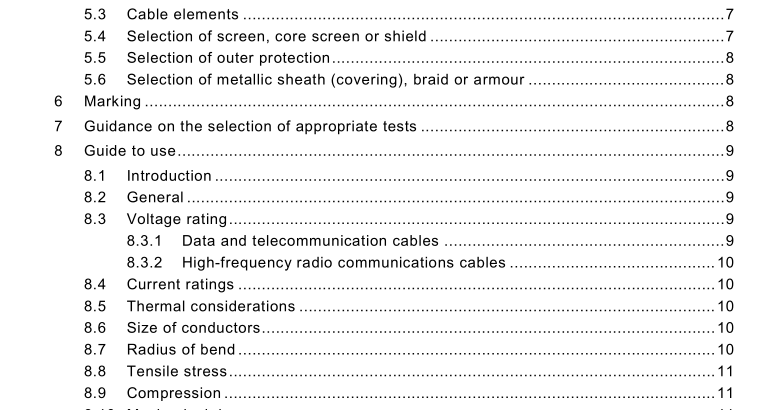IEC TR 60092-370:2009 pdf download – Electrical installations in ships – Part 370: Guidance on the selection of cables for telecommunication and data transfer including radio-frequency cables
5 Constructional considerations
5.1 Selection of conductor
Only circular copper conductors,either plain or metal coated,or copper covered steel arerecommended for use in a marine environment. Stranded conductors are recommended forgeneral use. Where the applicable product standard specifies solid conductors,considerationshould be given to the possible effects of vibration (due to the movement of the ship orinstallation) or movement (due to motion of the ship or installation).
The properties of copper conductors should be in accordance with IEC 60228.Joints in solidconductors or complete stranded conductors are not permitted,however joints in individualstrands are allowed.
NOTE When cables are subject to continuous flexing the advice of the manufacture should be sought.5.2Selection of insulation
The range of materials for use as conductor insulation should,where possible,be selectedfrom those listed in the IEC 60092-351 or as given in IEC 60096-0-1 and lEC 61156-5-1.Forcables operating at the higher frequencies the insulation may be solid, cellular or a foam skincomposite.The rated operating temperature of the insulating material should be at least 10 “Chigher than the maximum ambient temperature likely to exist, or to be produced, in the spacewhere the cable is installed.
The insulation should be continuous having a thickness as uniform as possible.The insulationshould be applied to fit closely to the conductor.
NOTEThe user should carefully select the insulation material regarding its electrical characteristics and intendeduse in the marine environment.
5.3Cable elements
The cores within each pair,triple, or quad should be clearly identified by colour or number asgiven in the applicable cable standard.The identification used should be durable and legible.
The choice of the maximum average length of lay in the finished cable should be selected withrespect to the specified crosstalk requirements, handling performance and the pair or quadintegrity.
5.4Selection of screen, core screen or shieldlf a screen is required, it may consist of the following:
a) a metallic laminated tape bonded to polyester and a drain wire in direct contact withthe metallic side of the tape,
b) plain or metal coated copper braid,
c) a metallic laminated tape bonded to polyester and a drain wire in direct contact with
the metallic side of the tape with a plain or metal coated copper braid.
The construction of the screen, core screen or shield should be as listed in IEC 60092-350 orthe applicable cable standard.Care should be taken when putting dissimilar metals in contactwith each other. Coatings or other methods of protection may be necessary to preventgalvanic interaction often encountered in the saliferous marine environment.
5.5Selection of outer protection
The range of materials for use as protective sheath should,where possible, be selected fromthose listed in IEC 60092-359 which have been proven by experience to be suitable for use inthe marine environment. Materials listed in IEC 60096-0-1 and lEC 61156-1 may also beconsidered, the material chosen should meet the requirements of this technical report.
The material selected should be compatible with the cable components with which it is incontact and compatible with the intended environment and operating temperature of the cable.
ln instances where the construction of a cable does not conform with a standard from theIEC 60092 series, it should be ensured that the material used as the protective sheath hasadequate mechanical strength in respect of the mechanical hazards to which it may besubjected during installation and service. The potential for corrosion,of underlying layers,encountered in the marine environment should also be considered.Attention is drawn to thelist of permitted protective coverings given in lEC 60092-350.
Due consideration should be given to fluid resistance for cables installed where watercondensation or harmful vapours (including oil vapour) may be present. In this instance,thecables should meet the appropriate fluid resistance requirements of Annex D of lEC 61892-4.NOTE Not all materials in lEC 60092-359 meet the fluid resistance requirement.
Also consideration should be given to the fire performance characteristics given in Clause 9.
The minimum thickness of sheath considered as being acceptable for cables for installationonboard a ship or offshore installation is 0,7 mm.
5.6Selection of metallic sheath (covering), braid or armour
The construction of the metal braid armour should be in accordance with lEC 60092-350.Thetype of metal braid armour should be carefully selected by the user in respect of not only themechanical hazards but also and potential for corrosion encountered in the marineenvironment.Care should be taken when putting dissimilar metals in contact with each other.Coatings or other methods of protection may be necessary to prevent galvanic interactionoften encountered in the saliferous marine environment.
